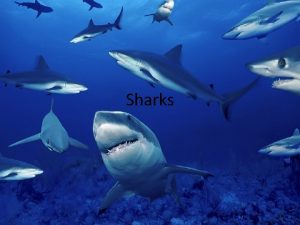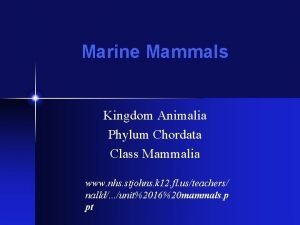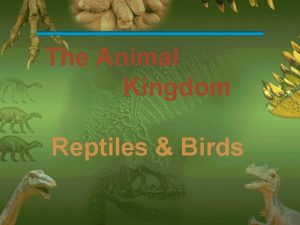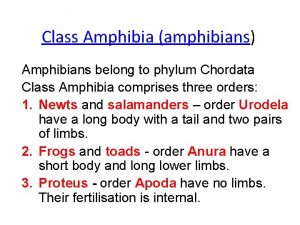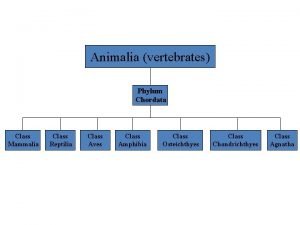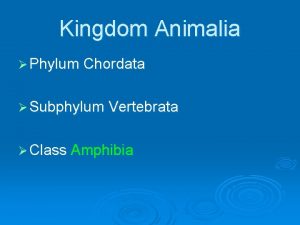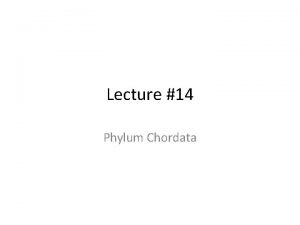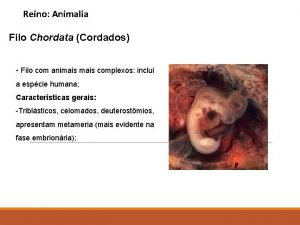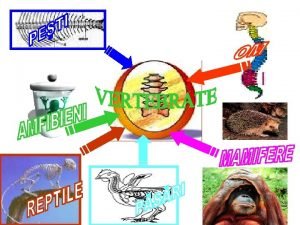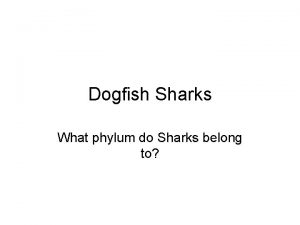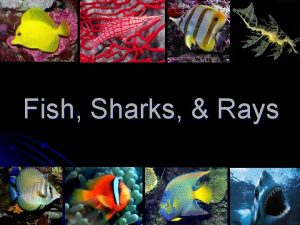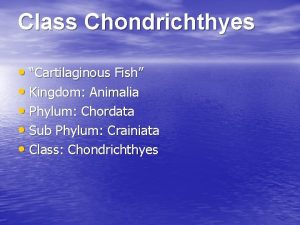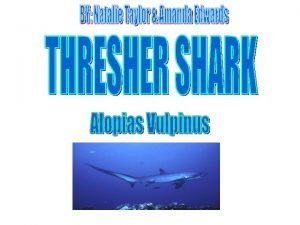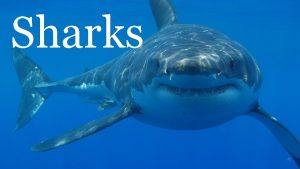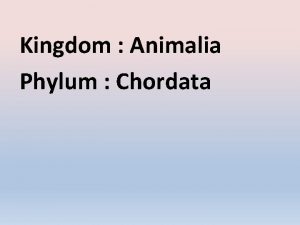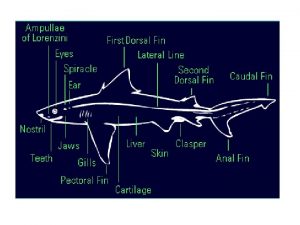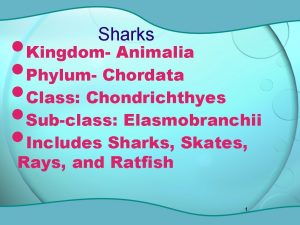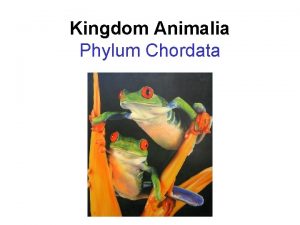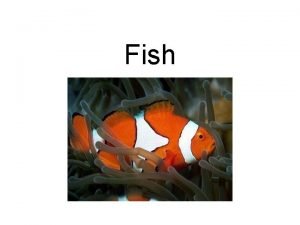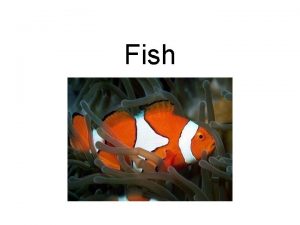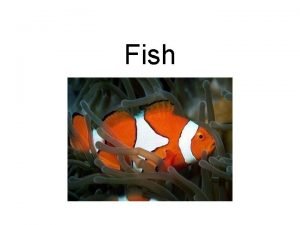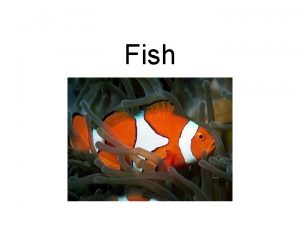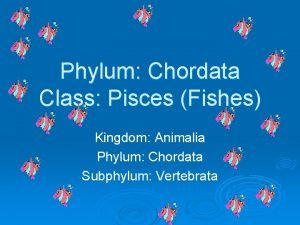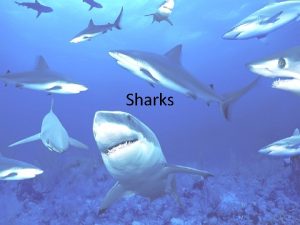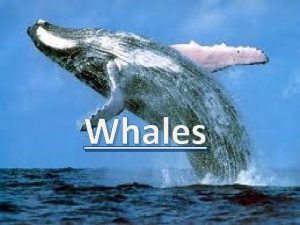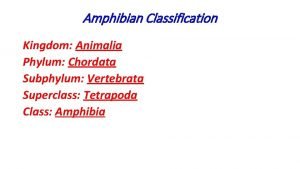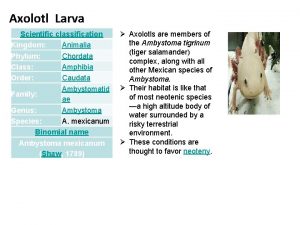Sharks Classification Kingdom Animalia Phylum Chordata Class Chondrichthyes































- Slides: 31

Sharks

Classification • Kingdom Animalia – Phylum Chordata • Class Chondrichthyes –Subclass Elasmobranchii » Superorder Selachimorpha • Known as “sea dogs” until the 16 th century – Name “shark” may have come from the Yucatec Maya


Evolution • Earliest sharks evolved 450 million years ago • Today – 440 species – Smallest – dwarf lanternshark (7 in) – Largest – whale shark (largest fish – 40 ft)

Skeleton • No bones – Use cartilage and connective tissue • Strong , but ½ the density of bone – Reduces weight saves energy – Cartilage may be calcified • “bone-like” – No functional rib cage • Must stay in water

Jaw • Covered in a layer of tesserae – Complex rigid surface • Single tile in a mosiac – Tiny hexagonal plates • Crystal blocks of calcium salts – Most sharks have one layer of tesserae • Great white sharks – up to five

Teeth • Embedded into gums rather than the jaw • Arranged into 2 -3 rows of 20 -30 teeth – Continuously replaced • Gums “conveyor belt” them to the front • Can shed 35, 000 teeth in a lifetime • Tooth characteristics determined by diet • Very important to fossil record – all that remains


Tooth Anatomy

Fins • Supported by unsegmented rays composed of proteins

Tail (Caudal) Fins • 6 different designs found in sharks – Shapes evolved due to different habitats and diets – All are heterocercal in design • Top is longer than the bottom


Buoyancy • No swim bladder • Large livers – Up to 30% of body mass – Contain squalene • Oil that is less dense that water • Sharks hunted for this oil –Put in capsules as a health supplement –Used in vaccines –Also available from plant sources

Respiration • Oxygen removed as water passes through the mouth and over the gills – Process known as ram ventilation • Most sharks can pump water over their gills while at rest –Some cannot (obligate ram ventilators) – Gills not covered (as with most fish)

Circulation • Sharks have a two chambered heart

Thermoregulation • Most sharks are poikilothermic (cold blooded) – Body temp is that of the environment • Family Lamnidae sharks can raise their body temp higher than the water temp (includes mako and great white) – Homeothermic – Strip of red muscle in center of body attached to the rete mirabile (miraculous net)

Rete Mirabile • Uses countercurrent flow design

Osmoregulation • Living in salt water • Large production of urea – Shark’s tissues isotonic (in balance with) the sea water • So, few sharks can live in fresh water – Bull sharks can change their kidney funtion to excrete the urea

Senses – Smell • Very keen olfactory sense – Can detect one part per million of blood in sea water – Even greater attraction to chemicals found in guts of organisms • Leads sharks to sewage outfalls

Olfactory Bulbs (in pink)

Senses – Sight • Eyes similar to most vertebrates – Well adapted to the dark marine environment • Use a tapetum lucidum (bright tapestry) –Reflects light back through the retina to increase amount of useable light –Humans do the same (eyeshine in a photo) –Can contract and dilate their pupils

Senses – Sight • Sharks have eyelids, but don’t blink – Water cleanses eyes • Use nictitating membranes – Covering that moves over eyes to protect them during attacks on prey


Senses – Hearing • May be able to hear prey many miles away – Hard to test • Small opening on each side of the head – Leads to the inner ear • Sense vibrations among the water molecules


Senses – Hearing • Lateralis system – System of canals within the lateral line • Runs the length of the body • Pores expose water to the system • Contains sensory cells with hair-like projections • Also helps with balance and movement

Lateralis System

Senses – Electroreception • Sharks can detect electromagnetic fields produced by all living organisms – Sharks have the greatest electrical sensitivity of any organism – Helps them find prey (even under the sand) – Use Ampullae of Lorenzini • Electrorecptor organs –Hundreds to thousands per shark

Pores (on a tiger shark)

Senses – Electroreception • Ocean currents travel through the magnetic field of the earth – Creates electric fields • May allow sharks to navigate the world’s oceans • Allows sharks to detect temperature gradients

 Kingdom animalia phylum chordata class mammalia
Kingdom animalia phylum chordata class mammalia Are sharks chordates
Are sharks chordates What are chordata
What are chordata Seal phylum
Seal phylum Diptera
Diptera Hammerhead shark vs great white
Hammerhead shark vs great white Reptiles order
Reptiles order Kingdom animalia phylum arthropoda
Kingdom animalia phylum arthropoda Cnideria diagram
Cnideria diagram Cnidaria characteristics
Cnidaria characteristics Phylum chordata class amphibia
Phylum chordata class amphibia Phylum chordata class reptilia
Phylum chordata class reptilia Phylum
Phylum Chordata phylum
Chordata phylum Reino cordados
Reino cordados Subincrengatura
Subincrengatura Old kingdom middle kingdom new kingdom
Old kingdom middle kingdom new kingdom Old kingdom middle kingdom new kingdom
Old kingdom middle kingdom new kingdom Youtube
Youtube Capital of egypt during the old kingdom
Capital of egypt during the old kingdom Dogfish shark class
Dogfish shark class Shark skates and rays are also called
Shark skates and rays are also called Chondrichthyes phylum
Chondrichthyes phylum What do thresher sharks eat
What do thresher sharks eat Why is having a scientific name important
Why is having a scientific name important Phylum class order
Phylum class order Euglena kingdom
Euglena kingdom Plant kingdom phylum class order
Plant kingdom phylum class order 8 levels of classification in order
8 levels of classification in order Horse class taxonomy
Horse class taxonomy What are the classifications of human?
What are the classifications of human? Class order family genus species
Class order family genus species

